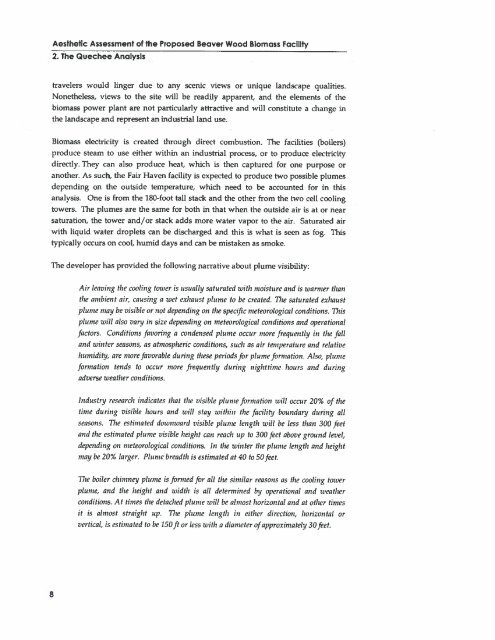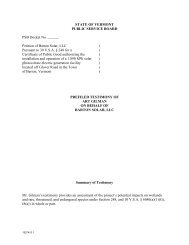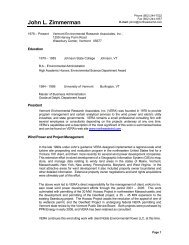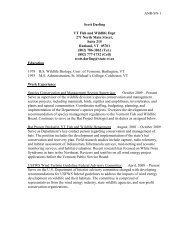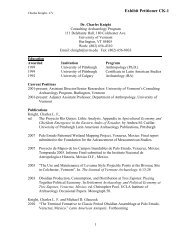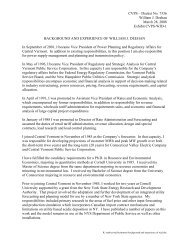Pre-Filed Testimony and Exhibits of David Raphael - Vermont Public ...
Pre-Filed Testimony and Exhibits of David Raphael - Vermont Public ...
Pre-Filed Testimony and Exhibits of David Raphael - Vermont Public ...
You also want an ePaper? Increase the reach of your titles
YUMPU automatically turns print PDFs into web optimized ePapers that Google loves.
Aesthetic Assessment <strong>of</strong> the Proposed Beaver Wood Biomass Facility<br />
2. The Quechee Analysis<br />
travelers would linger due to any scenic views or unique l<strong>and</strong>scape qualities.<br />
Nonetheless, views to the site will be readily apparent, <strong>and</strong> the elements <strong>of</strong> the<br />
biomass power plant are not particularly attractive <strong>and</strong> will constitute a change in<br />
the l<strong>and</strong>scape <strong>and</strong> represent an industrial l<strong>and</strong> use.<br />
Biomass electricity is created through direct combustion. The facilities (boilers)<br />
produce steam to use either within an industrial process, or to produce electricity<br />
directly. They can also produce heat, which is then captured for one purpose or<br />
another. As such, the Fair Haven facility is expected to produce two possible plumes<br />
depending on the outside temperature, which need to be accounted for in this<br />
analysis. One is from the 180-foot tall stack <strong>and</strong> the other from the two cell cooling<br />
towers. The plumes are the same for both in that when the outside air is at or near<br />
saturation, the tower <strong>and</strong>/or stack adds more water vapor to the air. Saturated air<br />
with liquid water droplets can be discharged <strong>and</strong> this is what is seen as fog. This<br />
typically occurs on cool, humid days <strong>and</strong> can be mistaken as smoke.<br />
The developer has provided the following narrative about plume visibility:<br />
8<br />
Air leaving the cooling tower is usually saturated with moisture <strong>and</strong> is wanner than<br />
the ambient air, causing a wet exhaust plume to he created. The saturated exhaust<br />
plume may be visible or not depending on the specific meteorological conditions. This<br />
plume will also vary in size depending on meteorological conditions <strong>and</strong> operational<br />
factors. Conditions favoring a condensed plume occur more frequently in the fail<br />
<strong>and</strong> winter seasons, as atmospheric conditions, such as air tempcratl4re <strong>and</strong> relative<br />
humidity, arc niorc favorable during these periods for plume formation. Also, plume<br />
formation tends to occur more frequently during nighttime hours <strong>and</strong> during<br />
adverse weather conditions.<br />
Industry research indicates that the visible plume formation will occur 20% <strong>of</strong> the<br />
time during visible hours <strong>and</strong> will stay within the facility boundary during all<br />
seasons. The estimated downward visible plume length will be less than 300 feet<br />
<strong>and</strong> the estimated plume visible height can reach up to 300 feet above ground level,<br />
depending on meteorological conditions. In the winter the plume length <strong>and</strong> height<br />
may be 20% larger. Plume breadth is estimated at 40 to 50 feet.<br />
The boiler chimney plume is formed for all the similar reasons as the cooling tower<br />
plume, <strong>and</strong> the height <strong>and</strong> width is all deternnned hi 1 operational <strong>and</strong> weather<br />
conditions. At times the detached plume will he almost horizontal <strong>and</strong> at other times<br />
it is almost straight up. The plume length in either direction, horizontal or<br />
vertical, is estimated to be 150 ft or less with a diameter <strong>of</strong> approximately 30 feet.


